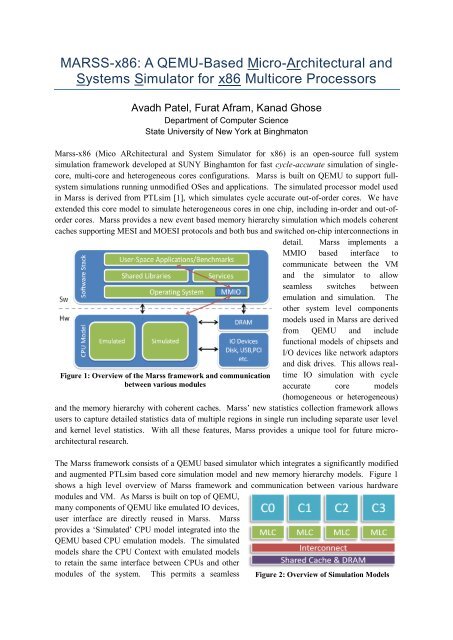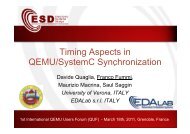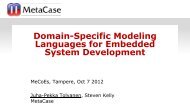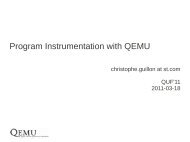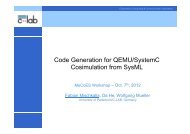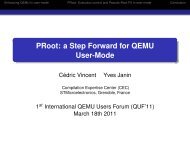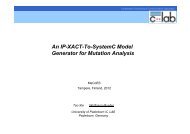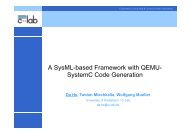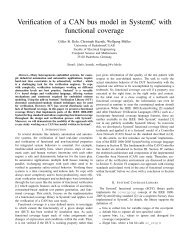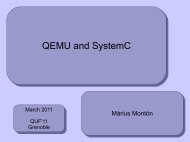MARSS-x86: A QEMU-Based Micro-Architectural and Systems ...
MARSS-x86: A QEMU-Based Micro-Architectural and Systems ...
MARSS-x86: A QEMU-Based Micro-Architectural and Systems ...
You also want an ePaper? Increase the reach of your titles
YUMPU automatically turns print PDFs into web optimized ePapers that Google loves.
<strong>MARSS</strong>-<strong>x86</strong>: A <strong>QEMU</strong>-<strong>Based</strong> <strong>Micro</strong>-<strong>Architectural</strong> <strong>and</strong><br />
<strong>Systems</strong> Simulator for <strong>x86</strong> Multicore Processors<br />
Avadh Patel, Furat Afram, Kanad Ghose<br />
Department of Computer Science<br />
State University of New York at Binghmaton<br />
Marss-<strong>x86</strong> (Mico ARchitectural <strong>and</strong> System Simulator for <strong>x86</strong>) is an open-source full system<br />
simulation framework developed at SUNY Binghamton for fast cycle-accurate simulation of singlecore,<br />
multi-core <strong>and</strong> heterogeneous cores configurations. Marss is built on <strong>QEMU</strong> to support fullsystem<br />
simulations running unmodified OSes <strong>and</strong> applications. The simulated processor model used<br />
in Marss is derived from PTLsim [1], which simulates cycle accurate out-of-order cores. We have<br />
extended this core model to simulate heterogeneous cores in one chip, including in-order <strong>and</strong> out-oforder<br />
cores. Marss provides a new event based memory hierarchy simulation which models coherent<br />
caches supporting MESI <strong>and</strong> MOESI protocols <strong>and</strong> both bus <strong>and</strong> switched on-chip interconnections in<br />
detail. Marss implements a<br />
MMIO based interface to<br />
communicate between the VM<br />
<strong>and</strong> the simulator to allow<br />
seamless switches between<br />
emulation <strong>and</strong> simulation. The<br />
other system level components<br />
models used in Marss are derived<br />
from <strong>QEMU</strong> <strong>and</strong> include<br />
functional models of chipsets <strong>and</strong><br />
I/O devices like network adaptors<br />
<strong>and</strong> disk drives. This allows real-<br />
Figure 1: Overview of the Marss framework <strong>and</strong> communication<br />
between various modules<br />
time IO simulation with cycle<br />
accurate core models<br />
(homogeneous or heterogeneous)<br />
<strong>and</strong> the memory hierarchy with coherent caches. Marss’ new statistics collection framework allows<br />
users to capture detailed statistics data of multiple regions in single run including separate user level<br />
<strong>and</strong> kernel level statistics. With all these features, Marss provides a unique tool for future microarchitectural<br />
research.<br />
The Marss framework consists of a <strong>QEMU</strong> based simulator which integrates a significantly modified<br />
<strong>and</strong> augmented PTLsim based core simulation model <strong>and</strong> new memory hierarchy models. Figure 1<br />
shows a high level overview of Marss framework <strong>and</strong> communication between various hardware<br />
modules <strong>and</strong> VM. As Marss is built on top of <strong>QEMU</strong>,<br />
many components of <strong>QEMU</strong> like emulated IO devices,<br />
user interface are directly reused in Marss. Marss<br />
provides a ‘Simulated’ CPU model integrated into the<br />
<strong>QEMU</strong> based CPU emulation models. The simulated<br />
models share the CPU Context with emulated models<br />
to retain the same interface between CPUs <strong>and</strong> other<br />
modules of the system. This permits a seamless<br />
Figure 2: Overview of Simulation Models
switch between emulated <strong>and</strong> simulated CPU models. Marss also implements a MMIO device<br />
interface (Figure 1), which provides a communication channel between the VM’s software <strong>and</strong><br />
simulated/emulated hardware components. Using this channel, software running in VM can send<br />
control signals or communication messages to the simulator. Figure 2 shows an overview of the CPU<br />
simulation model containing 4 cores, private L1 <strong>and</strong> L2 (MLC) caches, on-chip interconnect, shared<br />
cache <strong>and</strong> on-chip DRAM controller. We have extensively modified the core framework to allow<br />
users to simulate heterogeneous configurations, consisting of in-order <strong>and</strong> out-of-order cores on the<br />
same chip that shares cache <strong>and</strong> other resources. The heterogeneous framework also allows users to<br />
simulate different cache configurations. The out-of-order core model contains various structures like<br />
fetch queue, issue queue, re-order buffer, load-store queue, multiple register files, branch predictors<br />
etc. It also implements cycle-accurate simulation for a superscalar pipeline including register<br />
renaming, out-of-order issue, store to load forwarding, load-store aliasing, etc. A new statistics<br />
collection framework in Marss allows users to capture separate statistics of user mode <strong>and</strong> kernel<br />
mode activities in a single simulation run. Users can also set up the simulator to capture statistics of<br />
various regions of interest, for example for specific functions or loops, <strong>and</strong> collect them in a single<br />
simulation run.<br />
One of the most challenging issues in developing Marss was to move the PTLsim based simulation<br />
model out of Xen <strong>and</strong> clean up complexities that were specific for Xen. PTLsim required users to<br />
have root level access to set up <strong>and</strong> run simulations, required the installation of a customized Xen<br />
hypervisor, thus impeding its wide deployment. PTLsim also did not support the full set of MMX<br />
instructions, coherent caches <strong>and</strong> other components needed for full system simulation. One of the<br />
biggest design requirements for Marss was to create a full system simulation framework that was<br />
complete, <strong>and</strong> easy to set up <strong>and</strong> use. <strong>QEMU</strong> was our first choice in this respect because of its ability<br />
to run unmodified OS without any hardware support, full user space emulation capabilities <strong>and</strong> fast<br />
emulation support. Additionally, <strong>QEMU</strong> also allows users to create snapshots which are used in<br />
Marss to create checkpoints of various benchmarks at user-specified locations. Marss also takes<br />
advantage of <strong>QEMU</strong>’s clean separation of the virtual clock <strong>and</strong> the real clock by slowing down the<br />
virtual clock by the simulation speed of Marss (which is 1000x slower than a real high-end machine)<br />
<strong>and</strong> thus automatically delays various IO interrupts <strong>and</strong> timers of VM.<br />
Marss also inherits one of the most attractive characteristic of <strong>QEMU</strong> by providing an extensible<br />
framework that permits quick integration of customized or any 3 rd party simulation modules. Marss<br />
users have already integrated simulation modules like DRAMsim [2] to perform detailed DRAM<br />
simulations. There are ongoing efforts to integrate DiskSim [3] <strong>and</strong> FlashSim [4] into Marss. In<br />
general, Marss provides a unique full system simulation framework on top of <strong>QEMU</strong> for future<br />
micro-architectural <strong>and</strong> system level research focusing on multiple <strong>and</strong> heterogeneous execution<br />
cores.<br />
References:<br />
[1] PTLsim: <strong>x86</strong>-Cycle Accurate Processor Simulator, http://www.ptlsim.org<br />
[2] DRAMSim, http://www.ece.umd.edu/dramsim/<br />
[3] DiskSim, http://www.pdl.cmu.edu/DiskSim/<br />
[4] FlashSim: A Simulator for NAND Flash-<strong>Based</strong> Solid-State Drives


